Our writer travels to Lismore to hear what life is like on this small west coast island known for its lush landscapes…
MORE FROM SCOTLAND MAGAZINE
Words and photos by Scott Antcliffe
Lismore, an island just 10 miles long and one-mile wide with a population of only 160 people may sound like something from Robinson Crusoe. However, the name of another novel, Treasure Island, may more easily be applied here and interestingly, the author of that book,
Robert Louis Stevenson, was the grandson of Robert Stevenson, the civil engineer who designed and built the Lismore Lighthouse here in 1833. Lismore is situated at the very south of the Great Glen within Loch Linnhe between Oban and the Isle of Mull. Due to its location, the island has played a pivotal part in Scotland’s pre-history and the history of the West Highlands and Islands of the Inner Hebrides.
The island’s name is derived from the Gaelic ‘Lios Mòr,’ which roughly translates as ‘Great Garden’ and alludes to its rich, fertile limestone soil. Unlike other islands, which were used for sheep farming throughout the 18th, 19th and 20th centuries, Lismore was used to grow flax, grain, potatoes, and vegetables.
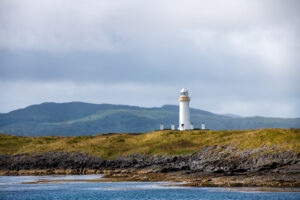
Lismore has a rich history dating back thousands of years, as evidenced by its many prehistoric sites, including standing stones, Bronze-Age cairns, Iron-Age duns, and Pictish brochs – the lighthouse was even built on the site of a former huge standing stone that marked the point of the low sun on the Winter Solstice.
The island was once part of the Gaelic kingdom of Dál Riata, which existed between the 6th and the 9th centuries AD. In the early Christian period, Lismore became an important centre of religious activity. St Moluag, an Irish missionary, founded a monastery on the island in the 6th century AD, which was an important centre of learning and spirituality.
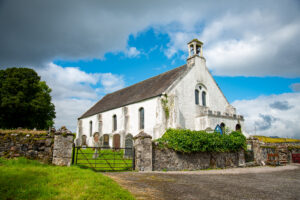
The island was an ecclesiastical centre during the medieval period, with the Bishop’s Seat of the Diocese of Argyll located on Lismore. In the early 13th century, Lismore became part of the Kingdom of the Isles, ruled by the Norwegian king, but in 1266, the Treaty of Perth returned the island to Scottish control. The island changed hands several times, with various clans, such as the MacDonalds, MacDougalls, and the Campbells, controlling it at different times, as evidenced in the ruins of places such as Castle Coeffin where each clan once held power.
Today, Lismore is a peaceful and picturesque island with a small, hard-working population. It remains an important site for historical and archaeological research and attracts visitors interested in its rich heritage, scenic beauty, and wildlife. The island and its waters are home to golden eagles, otters, hares, oyster catchers, ibis, cuckoos, seals, porpoises – even basking sharks. Red deer have been known to swim over from the Kingairloch Estate through Loch Linnhe.
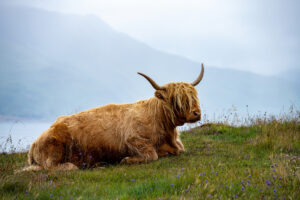
As well as an abundance of wildlife, Lismore has some very rare flora and fauna, with over 300 different types of wild flowers. Wild primroses, yellow irises, wood anemones and rare wild orchids can all be spotted, and Lismore even has patches of ancient Atlantic temperate rainforest. The combination of high rainfall and humidity, and low average temperatures, provides perfect conditions for scarce plants, lichens, and fungi to thrive.
Iris Smith has lived on the island for almost 10 years. She met her husband Robert when she came over from Holland to volunteer with textile artist Sarah Campbell at Balimackillichan Croft. The couple, much like many of the younger residents on the island, have set up their own business. Explore Lismore (explorelismore.co.uk) offers bespoke island tours, shepherding tours, and paddle board expeditions round the island, with delicious homemade produce for visitors to enjoy.
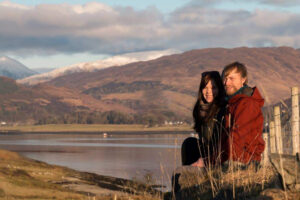
Like many who visit the island, Iris fell hard for Lismore.
“It’s a beautiful island but it’s the people here, that make it special,” she tells me. “It’s refreshing to live in a place where everyone knows each other and looks out for each other.” Iris also loves the sense of escapism island life offers. “Even though we have all this history and so many things to do here, it is still really quiet and relatively unknown. You can get a genuine experience of island life and a feeling for what it’s like to live on a small island,” she says.
Lismore has many families whose ancestry on the island goes back hundreds of years, but there has also been an influx of visitors who have come to work on crofts and have stayed.
It is quite a diverse community, with residents from Mexico, Senegal, Germany, France, South Africa, and Holland. Besides farming, much of the work islanders do is to ensure the smooth running of island life or to attract visitors, and so there is a private taxi firm, bike hire, a bakery, a grocery shop and a post office. Some farms also sell fresh produce and there are some independent producers such as Lismore Luminations (lismoreluminations.com), which specialises in hand-poured candles and other scented items.
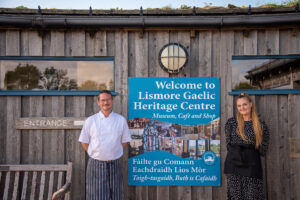
The hub of the island is the Lismore Gaelic Heritage Centre and Café (lismoregaelicheritagecentre.org/the-cafe), an accredited museum that focuses on the Gaelic and Celtic heritage of the island. It is open seven days a week from April to October and since opening its doors in 2007, it has won numerous awards.
The café is run by couple Dan Steel and Sarah McDonald, who took over ownership in 2018. Dan is the head chef and Sarah makes the mouth-watering cakes. Sustainability is at the heart of everything the café does, with the menu incorporating produce from the island as much as possible.
“Lots of people came from different countries to work here and just fell in love with the island,” Sarah says. “Apart from people who have family here and return to the island like us, people who live here have come for a short time and have ended up staying.”
Dan also says the pandemic had a profound effect on the community. “Since Covid, many of the younger generation have come back to Lismore as they didn’t want to be in their one-bedroom flats in Glasgow and can now work from home,” he says. “It’s great to see a growing number of younger couples moving back to the island.”
Each year in July, many people head back to the island to take part in what islanders call ‘Sports Day’ – the island’s own version of the Highland Games where families from the north of the island face their foes from the south in an almighty Tug o’ War, which I am told is something to behold. Lismore has a school with 10 children, which includes a nursery. The children learn French and Gaelic, and have their own vegetable garden. They go kayaking, abseiling, learn bushcraft, and study outdoors most of the summer term.
Lismore is certainly worth a visit, whether you’re coming for a day trip or planning to book into one of the B&Bs or self-catering places. You can get here by the foot ferry from Port Appin (just 10 minutes), or you can take the car ferry from Oban with CalMac Ferries (around 45 minutes). Either way, a visit here offers an authentic taste of small island life, with stunning scenery, wildlife, history, and culture to enjoy, not to mention friendly, welcoming locals.
The only problem is, you may find yourself staying much longer than planned.
This is an extract, read the full future in the July/August issue of Scotland, available to buy here from 16 June.
Read more:
Ahoy Portsoy: ACE Winches Scottish Traditional Boat Festival
MORE FROM SCOTLAND MAGAZINE

SCOTLAND MAGAZINE
Published six times a year, every issue of Scotland showcases its stunning landscapes and natural beauty, and delves deep into Scottish history. From mysterious clans and famous Scots (both past and present), to the hidden histories of the country’s greatest castles and houses, Scotland‘s pages brim with the soul and secrets of the country.
Scotland magazine captures the spirit of this wild and wonderful nation, explores its history and heritage and recommends great places to visit, so you feel at home here, wherever you are in the world.